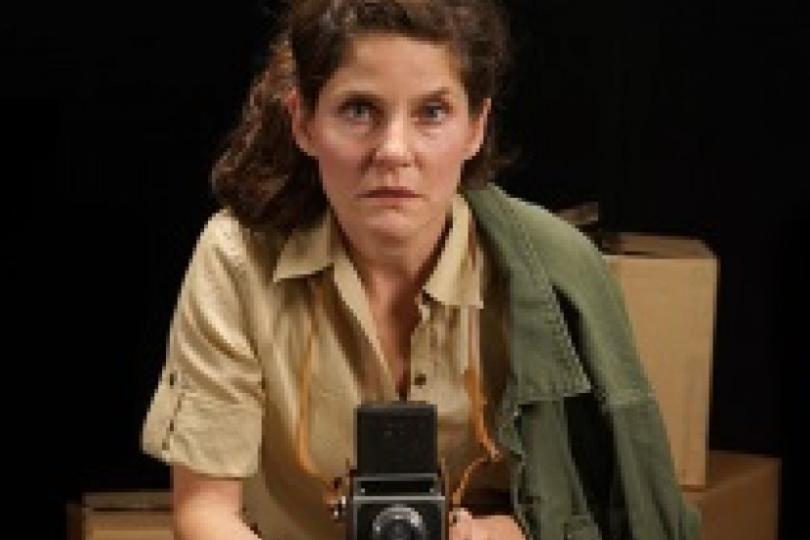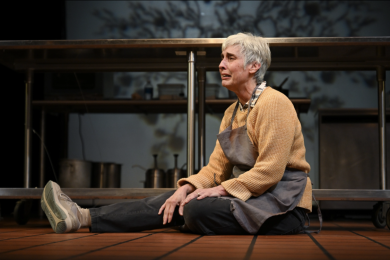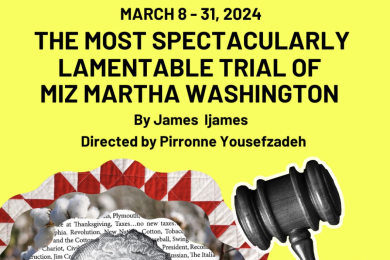REVIEW: 'Behind the Eye' at Park Square
Review

“Much of her life would be a negotiation between the act of seeing and the act of being seen.” – Ali Smith, on photojournalist Lee Miller
Part I: McReview of Behind the Eye
Immediately go.
If you are a reader who scans for the thumbs-up/thumbs-down quickie review, here you go. SEE THIS PLAY. THIS IS A REALLY GOOD PLAY. There! That was your review. Your work here is done.
Part II: Not the review. Part III is the review.
On the question of new work.
While I was noodling around with a draft of this thing in my head, I found myself reverting to my newscaster/critic voice – I do not know whence this voice comes, but it goes around spewing vague inanities in all my first drafts – and I thought, “This is a remarkable, flawed, and thrilling play about a remarkable, flawed, and difficult woman, and…”
Blah. Delete.
Find me a non-flawed play, and I will try to avoid it. Ditto a flawless woman, because ugh. And what does anyone mean when they say “remarkable,” anyway? What does anyone mean by “flawed”?”
I am tired of and seriously annoyed by the nonspecific, homogenizing, malt-o-meal critical language that gets recycled for a lot of new theater. Difficult, flawed, remarkable, original, challenging, brilliant – the terms are so soggy with overuse they’re meaningless. This language shows none of the gut-level response a new play can inspire, for or against; the terms betray no opinion, give no sign of the watcher’s reaction, and they give the reader no sign of what the play might have done, been, or achieved.
New theater is inherently flawed, inherently difficult, precisely because it is new. We don’t know it yet, haven’t encountered its story or its people or its ideas, haven’t integrated it into the schema of the familiar and the known dramatic world, so it jangles us newly, as it is meant to do. We leave the theater thinking about our actual response, rather than feeling simply soothed by the salve of the old saw, the favorite romantic comedy or sitcom-worthy family drama or heart-tugging tiny tragedy, which is often about as much tragedy as an audience is willing to take.
But that new bejanglement, that sense of powerful engagement with the work, is maybe the whole point of mounting new theater. At least it is why a lot of us crave and seek out and gobble up new plays, good and bad, because they are risky, they explore new terrain. The best new theater takes risks that have not really been taken before, or takes old risks in new ways. New theater falls over, flubs its lines, trips on its prose, gets drunk and rambles, abruptly changes course, and lets endings go on way too long.
Which is all to say this play jangled me, startled and caught me up short, careened around thrillingly, nearly popped with its own outward-pressing energy, was delicious, was flawed, and was very, very good – not only because it was a fantastic production, but also because it is a new, perhaps not quite finished, flawed, difficult, challenging, and truly beautiful play.
Part III: The review segment of the review.
In just over 100 minutes, Carson Kreitzer does her damnedest to wrangle one of the most complicated, fascinating, and nearly forgotten artists of the early 20th century, Lee Miller, into a tense, vibrating soliloquy told in that woman’s own voice. In Annie Enneking’s knockout portrayal of Miller, we are given an aching, sometimes brutal vision of a woman who really did play by her own mercurial rules, who changed faces and countries and selves at a whim, and who, for all her fame in her own time, was never really known.
Miller, a profoundly gifted photojournalist and combat reporter, was the only woman to report from the front lines in World War II. She was the first to photograph the use of napalm. Her shutter clicked on the execution of a prime minister, the death camps at Dachau, the Battle of Alsace, children dying in a wartime hospital, peasants in Hungary. She wrote articles from the war zones with the precision of a poet and a sense of story that much news of the day lacked. She loved photojournalism, lived for it, thrived while following the story all over the world.
But that’s not the woman anyone remembers. When she is remembered at all – usually in writings on other artists – Man Ray, Picasso, Duchamp, etc. – the descriptions of her simper and flounce along: she was “a muse to the Surrealists.” And “an exceptional cook.” “A woman of appetites.” In a particularly low blow, her entire body of work is dismissed in a line: she is remembered “mainly for the witty Surrealist images that permeate all her work.”
Actually, she’s much better known for the fact that she started her career as a fashion model, slept with various and sundry famous artists, and eventually – when she came home from the war, already an alcoholic, and moved to the English countryside to live as a wife, mother, and (see above) cook – got depressed.
Kreitzer’s play takes on Miller’s entire chronological history, from her abusive childhood through her last days dying of cancer, alone (in the words of the play) “in a farmhouse in the middle of fucking nowhere.” Enneking deftly time-travels from artistic and historic era to era, from the physical gesture and voice of a child, to a young woman who already describes herself as a too-ripe fruit that tends toward rot, to a woman undergoing the slow corrosive effects of time, and drink, as they wear away at the body, spirit, and the mind.
Enneking – a powerful performer in any instance, and one whose skills are drawn out by Leah Cooper’s* insightful, nuanced direction – uses both her voice and her body to sketch not just Miller’s personality – seductive, childish, coy, blunt, violent, broken by turns – but to move her character through the timespan of the play. Both her work and Cooper’s direction keep the play in literal motion, maintaining a tensile, constant, propulsive movement that feels fluid and organic, a testament to both Enneking’s training and physical strength, and the strength of the script, which does not pause for breath.
Trying to capture a woman’s life in a play, suspending it in all its detail like a fly trapped in amber – trying even to capture the essence of a woman who, like any other, morphs from one kind of creature into another, and then another, the whole of her life – is a powerfully ambitious goal for a single play, and in this case I think it is a mistake. It’s not because Enneking can’t handle the range of roles it requires – she can, and she does – and not because Kreitzer’s writing can’t hold up to it, because it can.
But despite a stunning performance, despite the gorgeous language of the script (which a local critic ridiculously blew off as “purple prose” – please), despite knock-your-socks-off tech and design, the number of eras this play traverses – eras of Miller’s life, and of history itself – is too many. The span of time Kreitzer captures is extraordinary, and she does capture those years; but I think the sheer quantity of historical information we are given overshadows the real subject of the play – which is not Miller’s ghastly childhood, not her years as a gamine “look of the moment” girl, not her period as a brave and brassy (but ever so sexy) take-no-nonsense New Woman; it’s not the alluring mythos of her years in Paris as an actual artist and putative muse, and not the details of her later life as a mother and wife, making her home a famous haven for “real” artists, while she cooked and drank herself to death in the kitchen.
We see the drama and clamor that surrounded Miller, the worshipful attentions of her husbands and lovers, the praise and awe of the world in which she moved, the thrill of careening through her life being daring and glamorous and terrible and adored – but we get only glimpses of what’s beneath the surface. Mostly what we see is how Miller performed the role of herself throughout the play she made of her life. We encounter an ephemeral figure, sketched by other people’s art and words, a mythos of a woman rather than one of bone and flesh.
The real story here – as Kreitzer indicates in her title – is the woman behind the camera, the woman behind the eye. But that is not the character we meet. We are so saturated with the kaleidoscopic shifting and changing of people, lovers, decades, and art forms, that I think we may lose sight of the woman herself. Then the audience becomes the seeing eye in question; and we are, inevitably and always, keeping her in her place, fixed on the stage, forever trying to create a role for herself that will finally fit.
I believe she did find that role in her lifetime, and I think this play – along with everything that I have ever read about her – only skims the surface of the most critical period of Miller’s life. The woman was a photojournalist. She spent her most generative, happiest years hot on the heels of the biggest war story of all time, chasing an image she could catch in a split-second frame. But this period – the one during which she saw rather than was seen, watched rather than posed or performed, is wedged between the two main portions of the play – her youth and her middle age – and it is eclipsed by the shadow those eras cast.
Surrealism to her left, the post-War era to her right, this play does not challenge the supposition that those artistic eras defined her more than she defined herself. It pays some, but not enough, attention to the element of Miller’s life that gave her joy and in many ways defined who she was, and gave her the only sense of self she had: photography as such, rather than as metaphor, which is how it is used in this play.
This may be one of the blips in this production that troubles me: the absence of any sense of Miller’s work. Watching the play, you cannot summon up her iconic images; only a few of her shots are described, and none by name. But there is specific, insistent – and brilliantly written – description of the works about her, works in which parts of her body are represented in paintings and art objects as detached, without context, as bodies and body parts in Surrealist art generally are. You cannot escape, nor should you, the implications of this for a woman bent on taking her own pictures, seeing her own world, and being her own eye.
Instead, she is memorialized (captured) in the works of Picasso and Man Ray, the latter who used an image of her eye as part of a work entitled Object to be Destroyed. You can’t help but love lines like “I’ve been cut up by the best of them,” or, from the mouth of Collette, whose portrait Miller took, “I didn’t like it when they smashed your face.”
And though this play is set at the heart of a revolution in photography, you’d never know it. There is allusion to the shifting place of the form in the world of art, but no direct address, and this is one of the moments the play could have explored something vital to Miller, rather than the image of her. Her career began in a time when photography was not considered art – it was considered, as her character says, “vulgar” – and ended just as an explosive, brilliant generation of photographers came to the fore. I have to wonder why the play doesn’t tell us what Miller saw, how she shot, what her style or signature were, anything about her work or her eye.
Instead, we get an overabundance of Surrealists (and a weird implication that Picasso was also a Surrealist, and two interpretations of how to say “de Chirico,” both of which were wrong) and quite a lot too much of Miller vamping when in fact Miller was studying with, and working with, Man Ray, who triggered the upending of photography as an art form early in Miller’s career. That she slept with him is incidental to me; I want to know, if he later took credit for her photos, which ones? What did they look like? How did she see?
There are photographic themes that run through the play – measures and terms in the dialogue, a few brief scenes in a darkroom – which feel like traveling music getting you through the interstices of her life. But those were not the interstices. Those were the moments – in the darkroom, behind the eye of the camera – when she was invisible to the world, and visible finally to herself.
Then there is the whole thing of a multitude of monologues directed at the audience, mostly monologues by the men (who are all top-notch) who loved Miller. Whether she loved them or not remains unclear. But they each in turn give a soliloquy in praise of her blinding beauty, her unlike-anyone-else-ness, her utter singularity as a woman. These hapless, hopelessly batty in love chaps speak beautifully of her – but the impact of placing the description of Miller in their mouths is that they are the ones who see her, and tell us what they see.
For all the time we spend in Miller’s extended monologues, listening to her tell us about her life, and perhaps a bit about herself – ultimately these monologues by her lovers are the play’s biggest mistake. The trouble isn’t structural, it isn’t a matter of a traditional or non-traditional play. The trouble is that the power of seeing Miller is given to them. They create her in this play, summing her up, framing and sketching her on the air. It is their eyes we borrow, and gaze with them at her. And though she says near the end of the play, “I am in here. I am not the thing that is painted,” in this play she is still the thing that is seen.
In the scope of history, we all – and all our work – are very small. Miller’s own history attests to that; she and her best work were virtually erased with time. This play strains to amend that, and in many ways does. But the attempt to contextualize one woman by placing her against the backdrop of half a century of artistic and political history allows her not to emerge, but instead obscures who she was.
In the breathtaking final scene, Miller asks, “I will sink, won’t I? No one will see what I have seen.”
We will, we could, this play could make that happen. All we need is to see not Miller, but through Miller’s eyes.
Part IV: Extremely cross alternate review of the reviews of this play.
As to the way this play has been reviewed and perceived by an apparently (as far as I can find) all-male cohort of critics who bumblingly have tried to take on the person of Miller and this Kreitzer play,
No, no, no, no, no.
Sigh.
What in the hell are you thinking?
What did you see? Did you even see this play? Or did you read the press release and default to your ready-made vocab for women’s writing (“food for thought,” “purple prose”) and email your story from your phone on your way out the door halfway through? Did you see the woman Kreitzer wrote, the woman who’s so close to visible in this play? Or did you see the woman as “a woman of appetites” (anyone want to wear that sign around her neck?)? A muse? A gamine, a pistol, a good lay, a smart gal?
Because I do not think that you & I saw the same play. Because I cannot find one review of Behind the Eye that does not bear the distinct whiff of small boys looking through the keyhole at the woman all of them want, but none can have.
As to persons who believe that the gender of the reviewer does not really influence the reviewer’s perception, interpretation, and basic understanding of a play, I invite you to take a gander at the theater critics in this town alone, and tell me again that the going theory of theater in these parts is a non-gendered state of affairs.
This is not to say that I do not like them. I like them fine.
*Editor's note: Leah Cooper is a co-founder of Minnesota Playlist. We do not believe that status unduly impacted this review.




